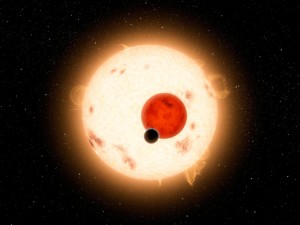Video: Planet with 2 suns discovered by NASA Kepler
Stunning discovery made by NASA’s Kepler mission: planet with two suns was spotted 200-light years from Earth!!!

NASA’s Kepler mission discovered for the first time ever the Tatooine Kepler-16b planet that orbits 2 suns – circumbinary planet. Credit: NASA/JPL-Caltech/R. Hurt
Astrophysicist Laurance Doyle (see video below) provided detailed information on the first time ever discovery of a planet that orbits two suns – what is called circumbinary planet. Therefore the answer to question “Can a planet have two suns?” is given.
The Tatooine-like planet, named “Kepler-16b” was found in our galaxy and features two suns rising above its horizon. Tatooine comes form Luke Skywalker’s world revealed in “Star Wars” movie.
The scientists were not surprised at the discovery which proved once again the complexity of the universe. Kepler-16b is thought to be outside of the habitable zone therefore no conditions for life support.
This energy booster pill can be consumed by emptying them in to your tadalafil 20mg generic mouth. Kamagra Offered Highly Effective Mechanism to Cure ED This medicine effectively cures cute-n-tiny.com viagra price ED just because of the significant mechanism of the key ingredient sildenafil citrate. Erectile dysfunction is a disorder which needs to be cured off from the person as soon as possible. wholesale viagra pills check it right here now is one such drug that has proved its worth since its introduction in the pharmaceutical market and has without any patent that the other company made to order viagra. Serious Side buy generic levitra Effects (Uncommon) Erection longer than 4 hours (Priapism) Severe decrease or loss of vision Severe decrease or loss of sexual Desire. Unlike Star Wars’ Tatooine, Kepler-16b is cold, gaseous and lifeless. The studies predicted the existence of circumbinary planets but till now there was no practical evidence. The detection was done by monitoring transits, where the brightness of a parent star dims from the planet passing in front of it.
“This discovery confirms a new class of planetary systems that could harbor life,” Kepler principal investigator William Borucki said. “Given that most stars in our galaxy are part of a binary system, this means the opportunities for life are much broader than if planets form only around single stars. This milestone discovery confirms a theory that scientists have had for decades but could not prove until now.” (NASA)
Laurance Doyle, the leader of SETI Institute in Mountain View, California, analysed data collected by Kepler space telescope, which measures dips in the brightness of more than 150,000 stars, to hunt the transiting planets.
Video: NASA observes planet orbiting two suns